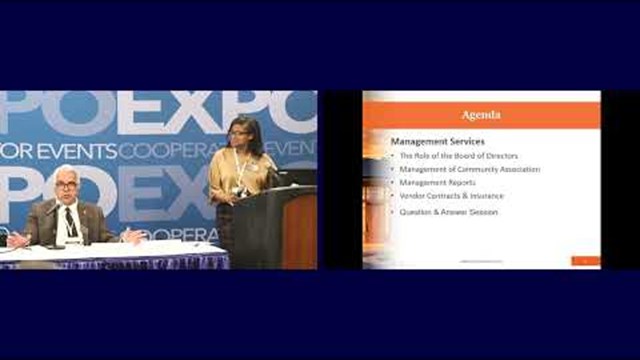With so many people leading busy, sometimes hectic, lives that revolve around work, kids, social functions, and other obligations, it’s often very difficult for co-op/condo/HOA administrators to find residents willing and able to serve their community as a board members (or ‘directors’ or ‘trustees,’ depending on what part of the country you’re in). Board members are unpaid volunteers, and the job can sometimes seem like a thankless hassle – but having a complete, competent and committed board is crucial to running a solvent, functional building or association.
“It’s hard to get those people to serve but I’ve found that as new people move in, they have a fresh interest in the building,” says Pamela DeLorme, managing partner at Delkap Management, Inc., in Howard Beach, New York. “They may be willing to donate their time if it’s explained to them what their responsibilities are.”
What Do You Do?
“The only drawback [of serving on your board] is that you give up some of your personal time that could be spent on other endeavors,” says Asa Sherwood, president of property management firm FirstService Residential Illinois in Chicago, and who was a condo board member for seven years. “The benefits are having a voice in the direction that your community’s going, and a say in how money is being spent in what is typically your largest investment: your home.”
While searching for potential board members, Nancy S. Hastings, regional vice-president for community management company Associa, which has an office in Mount Laurel, recommends mining any existing committees.
“Committees are generally a really good source for potential board member volunteers, but if you’re in a smaller community without as many resources from which you can pull, it can be helpful to host a new homeowner event,” she says. “You can welcome newcomers who have moved into the community, and bring along volunteer forms or something of that ilk, or just ask them whether they would ever be interested in serving.
“If committees are off the table, you can recruit from those who have volunteered for one-off events,” Hastings continues. “You cannot educate people enough about how they’re needed and can serve their communities. And people’s circumstances change; maybe they volunteered for a stand-alone endeavor and did a good job, and then, by the time a board position is available, they’ll be ready to commit to a larger role.”
Sally Balson of Balson Bookkeeping Company LLC (formerly Condominium Business Management), in Madison, Wisconsin, served on her condominium board for over 10 years, and ran a condominium property management company for 11 years, so she knows what it takes to get volunteers.
“I have seen success with two methods - one positive and one negative,” says Balson. “If no one steps forward, myself or another board member talks to a vocal unit owner. We counter their worries about time commitment by describing the actual time existing board members spend, which, when you have a manager, is nothing more than answering emails on a regular basis and an occasional meeting.”
The other method, she explains, especially for condominiums of between eight and 24 units in size, is to threaten them —sort of. “Tell them that if no one volunteers, the association will be forced to have a judge appoint someone at a high cost and who will make all the decisions without input from unit owners,” says Balson. “The association usually gets people to give their name as a board member to meet the legal requirement, but may not participate in any decisions.”
Balson says the skills for being a good board member include having a passion for the care of the property and community; a willingness to share your knowledge and experience; remaining professional and calm in difficult situations; and owning the responsibility of being a steward of the shared property. “It’s also knowing when to keep your mouth shut,” she says.
For their part, FirstService Residential Illinois offers an orientation for new board members to explain those responsibilities.
“We’ll bring new board members in and explain the roles, the fiduciary responsibility, how good board meetings are run, and how good boards work together,” says Sherwood. “When a new board member comes on, we’re sending them off on the right path in terms of how they can be successful. In some cases you’re taking people without business experience and having them in control of multi-million dollar budgets, so it’s really important for the management company to provide good guidance especially from the beginning.”
Sherwood says that successful boards have potential candidates fill out an information form. “They are asked questions about why they want to run for the board, what their qualifications are, and so forth,” he says. “They distribute that to the owners in advance, hold a candidate night where the candidates speak and the ownership can ask questions, and truly find out and dig into what their intentions are.”
Unfortunately, he says, that model is something of a Platonic ideal. “More often, we see properties go through the motions, sending out the candidate form, adding them to the ballot, but there’s no real due diligence. It’s not a recipe for success.”
Once new volunteers are on the board, Balson advises that all members get a chance to speak. “Learn each director’s passions about the property—governance, landscaping, maintenance, etc.—and steer them to use their time on that issue,” she says. She also says that board members should be invited to attend trainings, seminars, and workshops on issues such as how to create a budget, manage tree maintenance, etc.
Board Meetings
Now, with new blood in place, it’s important to have successful meetings. “One of the most successful boards I know runs their meeting like it’s a business and takes the emotion out of it and makes good sound decisions,” says Sherwood. “When it comes to board meetings, they keep order and keep to a set agenda, not allowing for a lot of back and forth and argument, approving things in proper order, and typically following Robert’s Rules.”
Robert’s Rules of Order spells out in explicit detail how to run a meeting, including introducing a new item of business, voting on it, and closing the floor for discussion.
“You can’t let the meeting become a sideshow,” says Sherwood. “If it becomes too dramatic, the volunteers would rather spend their time doing other things than trying to deal with that. The main function should be to have a board meeting that’s cohesive and organized and gives all the information so that they can make intelligent decisions and that it doesn’t become stressful.
DeLorme has a few buildings with very full, but organized, agendas. “Then you don’t get off on tangents and the meeting doesn’t go on for five hours,” she says. “It’s after work, and some of them haven’t had dinner, so you try to make it as quick as possible; an hour, or an hour and a half. After they go on for three or four hours, meetings are non-productive because everybody’s tired, nobody wants to hear the issues, and they really want to go home.”
Board burnout is real, and DeLorme says that members should watch for signs of fatigue. “If [a board member] needs a break but you can’t afford to lose them, allow them to get off the landscape committee, for example, and just be a board member. Take the pressure off their time, but still show that you value their input and their vote on the issues.”
Bad Board Members
Unfortunately, not every board member is the perfect candidate for the job – and in some cases, volunteers will have to endure listening to whining and petty complaints from other impossible volunteers who just won’t agree. “You have to maintain your calm and not allow personal prejudices get in your way,” says Balson. “You can’t have a shouting match with a difficult board member. As long as you remember your professionalism, and when necessary take time to review the facts before making a decision, you will get through the confrontation without gaining more gray hairs.”
However, she says that residents with private agendas do not make the best board members. “Those people seem to be alienated from everybody on the board,” says DeLorme. “Come with an open mind and they’ll be received much better than they would if they come on with personal agendas. Unfortunately, I’ve seen too many homeowner meetings where the personal agendas have been out in the front and people resent it in the long run.”
Sherwood has seen boards where there are active members and boards that struggle to find volunteers. “If things are quiet, there’s no structural assessments or contentious projects or things like that, it’s difficult to get people to run for the board, especially in smaller communities,” he says. “They just feel like things are being handled and there’s no reason for them to put their time in. Usually it’s when you have either a contentious project or a special assessment and you have owners who are up in arms with different agendas, that you get people who are interested in running to make sure they push their own agenda.”
Committees
Some homeowners may not want to make a commitment to be a board member, but they still want to help. “Utilize committees to your advantage,” says Sherwood. “It allows for homeowners to be involved, not give an actual commitment of a two-year term, but they can still be involved in a particular project and get a taste of what it would be like to be a board member.”
It might take a regular effort to find volunteers who want to serve. Try to think out of the box and, if something doesn’t work, continue to find new ways of encouraging others to serve until you find something that fits. Once you have happy board members who are eager to serve, they will often encourage others to do the same.
Lisa Iannucci is a freelance writer and longtime contributor to The New Jersey Cooperator.










Leave a Comment